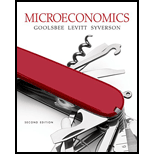
(a)
(a)
Explanation of Solution
Given information:
Supply function of scuba diving:
Calculation:
Intersecting point of demand and supply curve is the equilibrium point. The corresponding
Equilibrium price is $160.
Substitute the price in to the supply equation (Equation (2)) to calculate the equilibrium quantity.
Equilibrium quantity is 2,800 units.
Equilibrium price: The equilibrium price is the market price determined by the interaction between the quantity demanded and the quantity supplied.
Equilibrium quantity: The equilibrium quantity is the point where the quantity demanded is equal to the quantity supplied.
(b)
(b)
Explanation of Solution
To find out the consumer surplus, the chock price has to be calculated. The calculation of chock price is shown below:
Substitute the value of quantity as zero in Equation (1).
The demand chock price (maximum willing price) is $300.
Consumer surplus is calculated as follows:
Consumer surplus is 196,000.
Consumer surplus: Consumer surplus is the difference between the highest willing price of a consumer and the actual price that the consumer pays.
(c)
(c)
Explanation of Solution
To find out the producer surplus, the chock price has to be calculated. The calculation of chock price is shows below:
Substitute the value of quantity supply as zero in Equation (2).
The supply chock price (minimum acceptable price) is $12.
Producer surplus is calculated as follows:
Producer surplus is $130,662.
Producer surplus: Producer surplus is the difference between the lowest willing price accepted by the producer and the actual price received by the producer.
(d)
New equilibrium price and quantity, consumer, and producer surplus.
(d)
Explanation of Solution
Given information:
New demand function of scuba diving:
Calculation:
Intersecting point of demand and supply curve is the equilibrium point. The corresponding price in the equilibrium point is the equilibrium price. The calculation of equilibrium price is shown below:
Equilibrium price is $180.
Substitute the price in to the new demand equation (Equation (3)) to calculate the equilibrium quantity.
Equilibrium quantity is 3,400 units.
To find out the consumer surplus, the chock price has to be calculated. The calculation of chock price is shown below:
Substitute the value of quantity as zero in Equation (3).
The demand chock price (maximum willing price) is $350.
Consumer surplus is calculated as follows:
Consumer surplus is 289,000.
To find out the producer surplus, chock price is needed. It is already calculated in sub-part (c), thus producer surplus is calculated as follows:
Producer surplus is $192.661.
Equilibrium price: The equilibrium price is the market price determined by the interaction between the quantity demanded and the quantity supplied.
Equilibrium quantity: The equilibrium quantity is the point where the quantity demanded is equal to the quantity supplied.
Consumer surplus: Consumer surplus is the difference between the highest willing price of a consumer and the actual price that the consumer pays.
Producer surplus: Producer surplus is the difference between the lowest willing price accepted by the producer and the actual price received by the producer.
(e)
Better-off or worse-off situation.
(e)
Explanation of Solution
The increase in demand creates a better-off for both consumers and producers, because both party’s surplus is increased. The calculation of total increment in consumer surplus is shown below:
Total increment in consumer surplus is $93,000.
The calculation of total increment in producer surplus is shown below:
Total increment in producer surplus is $93,000. Thus, increase in demand increases the consumer’s and producer’s surplus, therefore both have better-off.
Consumer surplus: Consumer surplus is the difference between the highest willing price of a consumer and the actual price that the consumer pays.
Producer surplus: Producer surplus is the difference between the lowest willing price accepted by the producer and the actual price received by the producer.
Want to see more full solutions like this?
Chapter 3 Solutions
Microeconomics